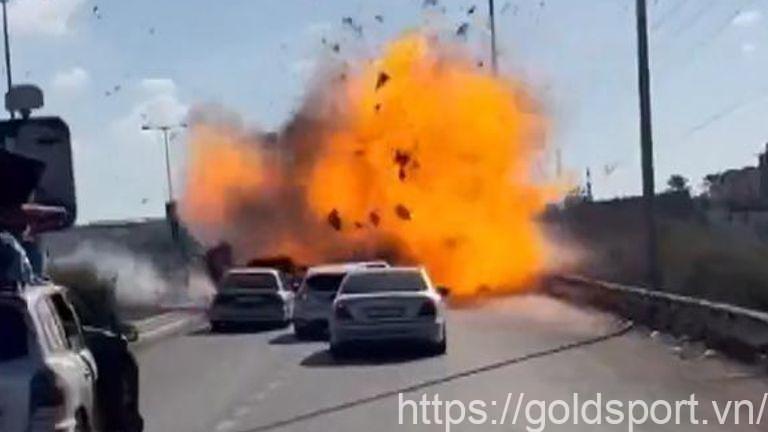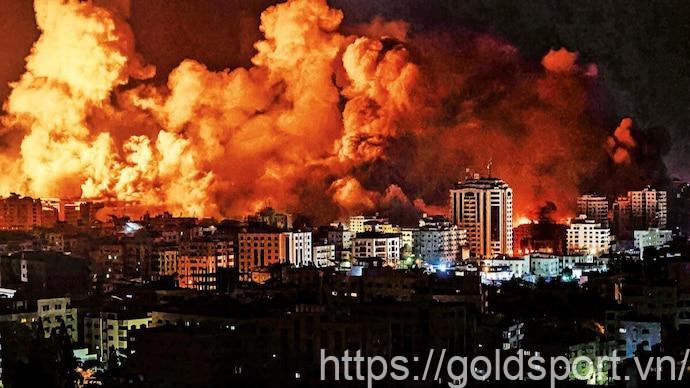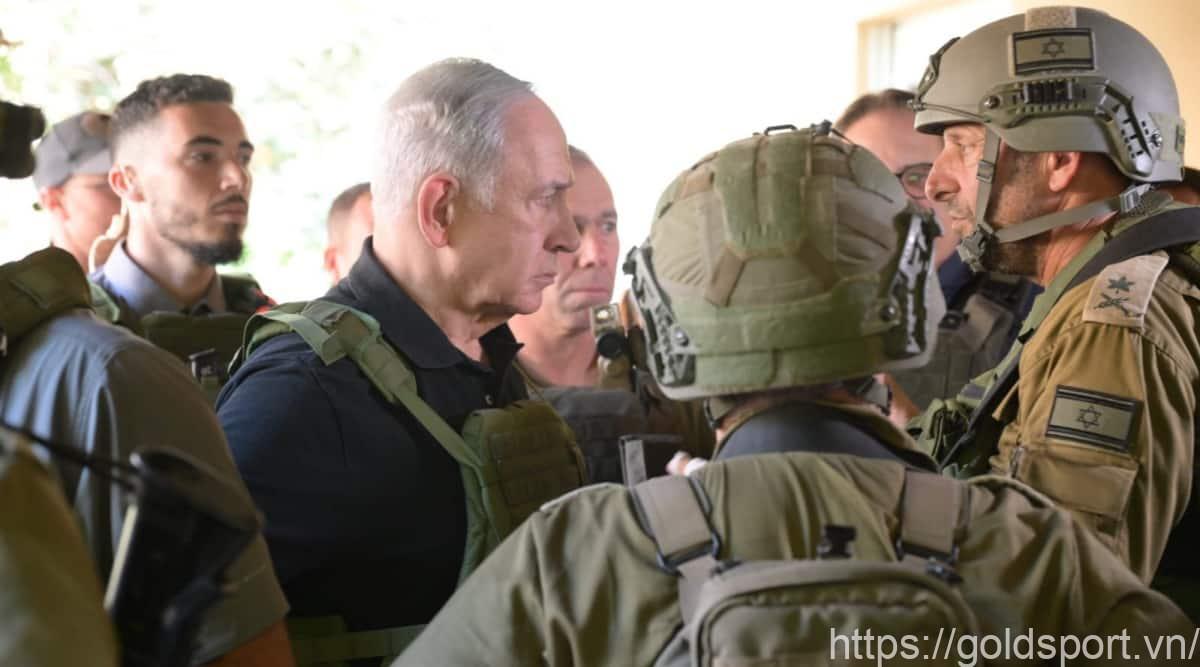The Israel Hamas War in Gaza: Hamas Footage Leak
Discover the complexities and consequences of the Israel-Hamas war in Gaza with Goldsport. Gain insights into the historical context, root causes, and recent escalation of the conflict. Explore the impact on the people of Gaza, including the humanitarian crisis and mass displacement. Learn about international response and diplomatic efforts to resolve the conflict. Assess the military strategies employed by Israel and Hamas, and delve into the future implications and potential paths to peace. Stay informed and understand the multifaceted nature of the Israel-Hamas war in Gaza with Goldsport.

| Key Takeaways |
|---|
| The Israel-Hamas conflict in Gaza has led to a dire humanitarian crisis and widespread displacement. |
| The root causes of the conflict and historical context play a significant role in understanding the ongoing tensions. |
| Recent escalation of violence has resulted in a devastating impact on the people of Gaza, with hospitals on the verge of losing electricity and limited access to essential supplies. |
| International response and diplomatic efforts are underway to find a resolution and alleviate the suffering of civilians. |
| An analysis of military strategies employed by Israel and Hamas provides insights into the nature of the conflict. |
| The future implications and road to peace require careful analysis and consideration of possible solutions. |
The Israel-Hamas War in Gaza: Understanding the Confict
Overview of the Israel-Hamas Conflict in Gaza
The Israel-Hamas conflict in Gaza is a long-standing and complex dispute that has resulted in multiple rounds of violence and destruction over the years. It is rooted in deep-seated political, territorial, and ideological differences between Israel and Hamas, the militant group that governs the Gaza Strip. The conflict involves a cycle of retaliatory attacks and military operations, with both sides claiming self-defense and blaming the other for initiating hostilities. The ongoing conflict has had severe humanitarian consequences for the people of Gaza, who have endured immense suffering and displacement.
Root Causes and Historical Context of the Conflict
To understand the Israel-Hamas conflict in Gaza, it is crucial to delve into its root causes and historical context. The conflict traces back to the Israeli occupation of Palestinian territories following the 1967 Six-Day War, which led to the establishment of Israeli settlements in the West Bank and Gaza Strip. Over time, tensions escalated due to issues such as land disputes, control over Jerusalem, access to resources, and the right of return for Palestinian refugees. The rise of Hamas as a political and military force in Gaza further complicated the situation. Factors such as economic deprivation, political marginalization, and differing visions for the future of Palestine have fueled the conflict and hindered efforts towards a peaceful resolution.
Recent Escalation: Trigger Events and Current Situation
The recent escalation in the Israel-Hamas conflict in Gaza can be attributed to a series of trigger events that reignited long-standing grievances. Tensions began rising in April 2021 with clashes between Israeli security forces and Palestinian worshippers at the Al-Aqsa Mosque compound in Jerusalem. Subsequent responses, including evictions of Palestinian families from East Jerusalem neighborhoods and Hamas launching rockets into Israeli territory, led to a full-scale military confrontation. The current situation is marked by devastating airstrikes by Israel targeting Hamas infrastructure, rocket attacks from Gaza into Israel, and a mounting humanitarian crisis in Gaza. International efforts to broker a ceasefire and bring an end to the violence are underway, but the path towards a lasting resolution remains challenging.
Overview of the Israel-Hamas Conflict in Gaza
Historical Background
The Israel-Hamas conflict in Gaza is a long-standing and complex issue that stems from historical tensions between Israelis and Palestinians. It is rooted in the broader Israeli-Palestinian conflict, which dates back to the establishment of the State of Israel in 1948 and the displacement of hundreds of thousands of Palestinians. Over the years, the conflict has evolved, with Hamas, an Islamic political and military organization, emerging as a key player in Gaza.
Key Players: Israel and Hamas
The conflict primarily involves two main actors: Israel, a sovereign state in the Middle East, and Hamas, an Islamist group that controls the Gaza Strip. Israel views Hamas as a terrorist organization and holds it responsible for attacks on Israeli civilians. Hamas, on the other hand, sees itself as a resistance movement fighting against Israeli occupation. The conflict between these two entities has resulted in numerous clashes, including military confrontations and rocket attacks.
Ongoing Struggles and Ceasefire Attempts
The Israel-Hamas conflict has been characterized by cycles of violence punctuated by periods of relative calm and attempted ceasefire agreements. Despite international efforts to broker peace and de-escalate tensions, both sides have engaged in retaliatory actions, leading to casualties and widespread destruction. The conflict has had significant humanitarian consequences for the people of Gaza, who have experienced displacement, shortages of essential resources, and a deteriorating quality of life. Efforts to achieve a lasting resolution continue, but reaching a comprehensive agreement remains a significant challenge.

Root Causes and Historical Context of the Conflict
The Israeli-Palestinian Conflict: Origins and Deep-rooted Tensions
The roots of the Israel-Hamas conflict in Gaza can be traced back to the broader Israeli-Palestinian conflict, which dates back to the early 20th century. The establishment of the state of Israel in 1948 led to the displacement of hundreds of thousands of Palestinians, fueling resentment and grievances. Over the years, tensions have escalated due to disputes over territory, self-determination, and the status of Jerusalem.
The Rise of Hamas: A Catalyst for Conflict
Hamas, an Islamist political and military organization, emerged in the late 1980s as a rival to the Palestinian Authority. Its rise to power was fueled by frustration with the lack of progress in peace negotiations with Israel. Hamas gained support through its provision of social services and its resistance against Israeli occupation. However, its refusal to recognize Israel’s right to exist and its use of violence have been major stumbling blocks in the peace process.
Settlements and Occupation: Disputes over Land and Resources
One of the key issues contributing to the conflict is Israel’s policy of settlement expansion in the occupied territories. The construction of Israeli settlements in the West Bank and East Jerusalem has been a major point of contention, as it is seen as an obstacle to achieving a viable Palestinian state. The control over land and resources, including water, has exacerbated tensions and led to clashes between Israeli settlers and Palestinians.

Recent Escalation: Trigger Events and Current Situation
Escalation Timeline
In recent weeks, tensions between Israel and Hamas have escalated dramatically, leading to a full-scale war in Gaza. The trigger events that set off this latest round of violence can be traced back to the forced evictions of Palestinians in the Sheikh Jarrah neighborhood of East Jerusalem, as well as clashes between Israeli police and Palestinian worshippers at the Al-Aqsa Mosque during Ramadan. These incidents ignited widespread protests and unrest, further fueling the already simmering tensions between Israelis and Palestinians.
Airstrikes and Rocket Attacks
Following the initial clashes, Hamas, the militant group controlling the Gaza Strip, began launching rocket attacks targeting Israeli cities, including Jerusalem and Tel Aviv. Israel responded with a massive aerial bombardment campaign, targeting Hamas infrastructure and military installations in Gaza. The exchange of airstrikes and rocket attacks has resulted in a significant loss of life on both sides, with civilians bearing the brunt of the violence.
Current Situation and Impact
As the conflict continues, the situation in Gaza has deteriorated rapidly. The Israeli airstrikes have caused widespread destruction, damaging vital infrastructure such as hospitals, schools, and residential buildings. The humanitarian crisis in Gaza is escalating, with shortages of essential supplies like water, food, and medical aid. Tens of thousands of Palestinians have been displaced from their homes, seeking shelter in overcrowded schools and makeshift camps. The international community has called for an immediate ceasefire and intensified efforts to provide humanitarian assistance to those affected by the conflict. However, finding a resolution to the deep-rooted issues that fuel this conflict remains a complex challenge.

Impact on the People of Gaza: Humanitarian Crisis and Displacement
1. Deteriorating Humanitarian Conditions
The Israel-Hamas conflict in Gaza has resulted in a severe humanitarian crisis, with the civilian population bearing the brunt of the violence. The ongoing airstrikes and blockade have led to a shortage of essential supplies such as food, water, and fuel. Hospitals are on the verge of losing electricity, threatening the lives of thousands of patients, while people are resorting to drinking dirty or sewage-filled water, risking the spread of disease.
2. Mass Displacement and Homelessness
The conflict has forced hundreds of thousands of Palestinians to flee their homes, seeking safety from the airstrikes and ground invasion. More than 1 million people have been displaced, with many seeking refuge in overcrowded schools and facilities provided by the UN agency for Palestinians. The displacement has created a dire situation, with limited access to basic necessities and an increased risk of further casualties.
3. Psychological Trauma and Emotional Distress
The continuous bombardment and fear of violence have taken a toll on the mental health of the people in Gaza. Children, in particular, are experiencing high levels of psychological trauma and emotional distress due to the loss of loved ones, destruction of their homes, and constant exposure to violence. The long-lasting impact of this trauma on the population, especially the younger generation, is a significant concern that will require extensive support and resources for recovery.
4. Struggling Healthcare System
Gaza’s healthcare system is overwhelmed and struggling to cope with the influx of injured civilians. Hospitals are running out of essential medical supplies and generator fuel, putting thousands of lives at risk. The lack of adequate healthcare facilities and resources further exacerbates the crisis, leaving many without access to critical treatments and care.
5. International Aid Efforts and the Call for Immediate Action
The dire situation in Gaza has prompted international humanitarian organizations and countries to call for immediate action to alleviate the suffering of the people. Efforts are underway to provide humanitarian aid and support, but access to Gaza remains a challenge due to the ongoing conflict. The international community must work together to ensure the delivery of essential supplies, facilitate medical evacuations, and address the urgent needs of the population affected by the conflict.

International Response and Diplomatic Efforts to Resolve the Conflict
International Community Condemns the Violence and Calls for Ceasefire
The Israel-Hamas conflict in Gaza has garnered significant attention and condemnation from the international community. World leaders, including those from the United States, European Union, and Arab nations, have called for an immediate ceasefire to halt the violence and protect civilians caught in the crossfire. They have expressed concerns about the humanitarian crisis unfolding in Gaza and emphasized the need for diplomatic solutions to de-escalate the situation.
Role of Regional and Global Powers in Mediation
Several regional and global powers have taken on the role of mediators to facilitate negotiations between Israel and Hamas. Egypt, traditionally a key mediator between the two sides, has been actively engaged in diplomatic efforts to broker a ceasefire. The United Nations, through its Secretary-General and relevant agencies, has called for an end to hostilities and urged both parties to engage in meaningful dialogue. Additionally, other countries like Jordan and Qatar have also played a role in mediating discussions and encouraging a peaceful resolution to the conflict.
The Challenges of Achieving a Lasting Peace
Despite international efforts, achieving a lasting peace agreement remains a significant challenge in the Israel-Hamas conflict. The deep-rooted political, territorial, and ideological issues between the two parties make finding common ground difficult. Moreover, there is a lack of trust and mutual recognition between Israel and Hamas, further complicating the negotiation process. The involvement of external actors with their own geopolitical interests also adds complexity to the situation. Nonetheless, sustained diplomatic efforts continue in the hopes of reaching a ceasefire agreement and creating conditions for long-term peace in Gaza.

Assessment of Military Strategies Employed by Israel and Hamas
Israel’s Military Strategy
Israel’s military strategy in the conflict with Hamas in Gaza has been focused on targeted airstrikes, aimed at destroying Hamas’ infrastructure, rocket launchers, and tunnels used for military purposes. The Israeli Defense Forces (IDF) have employed precision airstrikes to minimize civilian casualties and have utilized advanced intelligence gathering and surveillance technologies to identify and neutralize Hamas targets.
Hamas’ Military Strategy
Hamas, on the other hand, has employed a combination of guerrilla warfare tactics and rocket attacks against Israel. Their strategy involves launching rockets from populated areas, using civilian infrastructure as cover, and building an extensive network of underground tunnels. By operating within civilian areas, Hamas aims to create a dilemma for Israeli forces, forcing them to choose between avoiding civilian casualties or targeting Hamas militants.
Assessment of Effectiveness
The effectiveness of Israel’s military strategy lies in its ability to cripple Hamas’ military capabilities, disrupt their command structure, and limit their ability to launch attacks. The IDF’s use of advanced technology and intelligence has enabled them to target key Hamas installations while minimizing collateral damage. However, the continued rocket attacks from Hamas demonstrate that their military capabilities have not been completely neutralized.
Civilian Casualties and International Criticism
The conflict between Israel and Hamas has sparked international criticism due to the high number of civilian casualties. While Israel has emphasized its efforts to avoid civilian harm through precision targeting and warning systems, critics argue that the densely populated nature of Gaza makes it difficult to entirely prevent civilian casualties. Additionally, the use of civilian infrastructure by Hamas has raised concerns about human rights violations and potential war crimes.

Future Implications and the Road to Peace: Analysis and Possible Solutions
Analysis of the Conflict’s Future Implications
The Israel-Hamas war in Gaza has far-reaching implications for the future. It not only deepens the already existing humanitarian crisis but also exacerbates the long-standing tensions between Israel and Palestine. The conflict has the potential to escalate further and draw in regional actors, leading to a broader regional conflict. The continued violence and displacement of Palestinians in Gaza have severe social, economic, and psychological consequences that will require significant efforts to address.
Possible Solutions for Achieving Peace
Finding a lasting solution to the Israel-Hamas conflict is a complex task that requires careful consideration of various factors. Diplomatic efforts, backed by international support and mediation, are crucial in de-escalating the situation and fostering dialogue between the parties involved. Key elements for achieving peace include addressing the underlying grievances of both Israelis and Palestinians, ensuring equitable access to resources, and promoting a comprehensive political settlement based on a two-state solution. Additionally, efforts should be made to rebuild trust, foster reconciliation, and promote economic development in the region. Ultimately, a sustainable peace can only be achieved through a collective commitment to dialogue, compromise, and respect for human rights.
The information presented in this article is a compilation of various sources, including Wikipedia.org and different newspapers. Although we have taken great care to verify the accuracy of the information, we cannot assure that every detail is completely accurate and verified. Therefore, we advise you to exercise caution when citing this article or using it as a reference for your research or reports.




